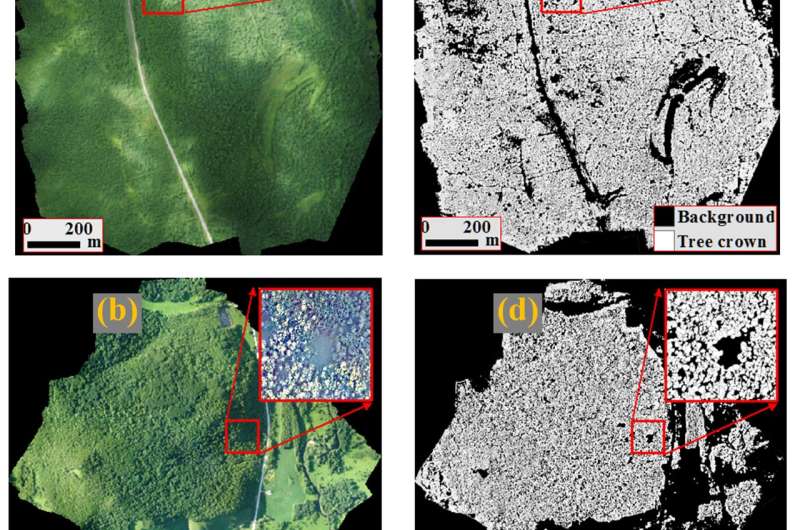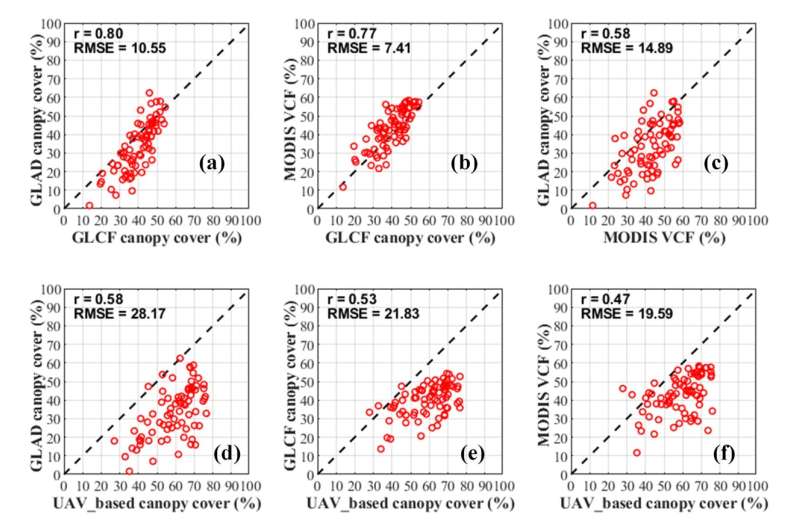An international research team has developed a new algorithm called BAMOS to better distinguish tree crowns and understories based on UAV-based images. Credit: Tianyu Yu & wenjian Ni, Aerospace Information Research Institute, Chinese Academy of Sciences
Satellite mapping, bolstered by algorithmic assessment, provides an indispensable view of Earth's canopy covering. The fraction of ground covered by tree crowns serves as a critical parameter for measuring forest ecosystems and potential carbon sinks. The maps are typically assessed by visually reviewing the satellite images or by cross-examining overlapping views but are rarely confirmed via field observations due to the sheer size of coverage and difficult terrain. Now, with the advent of unmanned aerial vehicles (UAV) equipped with high-resolution cameras, researchers are getting a better look at the greenery and calling the maps' accuracy into question.
But it's not as simple as better visuals—cameras are limited to how they process spectral information, meaning the greens of a canopy and its understory may not be as nuanced when viewed directly by the human eye. To better assess canopy coverage in northeast China, an international research team developed a new algorithm called BAMOS to better distinguish tree crowns and understories based on UAV-based images.
They published their method and results on Jan. 10 in the Journal of Remote Sensing.
"Canopy covers are basic parameters for studies on forest ecosystems and global carbon budgets," said paper author Wenjian Ni, professor in the State Key Laboratory of Remote Sensing Science, the Aerospace Information Research Institute, Chinese Academy of Sciences. "Several well-known global maps have been released in the last decade, but before they can be fully applied with confidence, they need to be independently assessed—which is a problem due to the unavailability of sufficient reference data."
To clear the bottleneck, the researchers designed BAMOS to combine the spectral information from a digital orthophoto map—a computer-generated image with a map's clean description of terrain details and the visual details of an aerial photo—with a digital surface model, which displays the environment's features from a top-down view.
Scientists from Aerospace Information Research Institute, Chinese Academy of Sciences find about 20% underestimation of forest canopy covers in three well-known global maps. Credit: Tianyu Yu & Wenjian Ni, Aerospace Information Research Institute, Chinese Academy of Sciences
"Samples of canopy covers were produced by applying the BAMOS method on the UAV images collected at 77 sites across Daxing'anling forested area in the northeast of China," Ni said. "Results showed that the canopy cover extracted by the BAMOS was highly correlated to visually interpreted ones, with an error of about 5.7%"
The researchers used this information to assess the accuracy of three widely used global maps: Global Land Analysis and Discovery laboratory (GLAD) map, Global Land Cover Facility (GLCF) map and MOD44B Version 6 Vegetation Continuous Fields (MODIS VCF) map.
"Systematic underestimations of about 20% were obviously noticed in all three global maps, although all three had good consistency when compared to one another," Ni said, noting they only compared the northeast China region. "Our study indicates the need for independent assessments of other locations on these global maps."
While both GLAD and GLCF captured the dominate spatial patterns, GLAD tended to miss scattered trees and GLCF did not capture non-tree areas. Ni also explained that while temporal differences between when the BAMOS information was collected and when the maps were developed may contribute to some of the underestimation, but the data shows time isn't the primary contributor.
"The GLAD map was developed about eight years prior to the BAMOS data collection and shows quite a different spatial pattern, especially in forested regions approaching to non-forest areas," Ni said. "This may be related to the growth of young forests during the eight-year interval. Nevertheless, MODIS VCF still has obvious underestimations with our data, taken at the same time, indicating the temporal inconsistency in this study cannot be the main factor causing such discrepancies, and further assessments are needed."
Other contributors include Tianyu Yu, Zhiyu Zhang and Qinhuo Lin, State Key Laboratory of Remote Sensing Science, the Aerospace Information Research Institute, Chinese Academy of Sciences; and Guoqing Sun, Department of Geographical Sciences, University of Maryland. Ni, Yu and Liu are also affiliated with the University Chinese Academy of Sciences.
More information: Tianyu Yu et al, Regional Sampling of Forest Canopy Covers Using UAV Visible Stereoscopic Imagery for Assessment of Satellite-Based Products in Northeast China, Journal of Remote Sensing (2022). DOI: 10.34133/2022/9806802
Provided by Journal of Remote Sensing
























